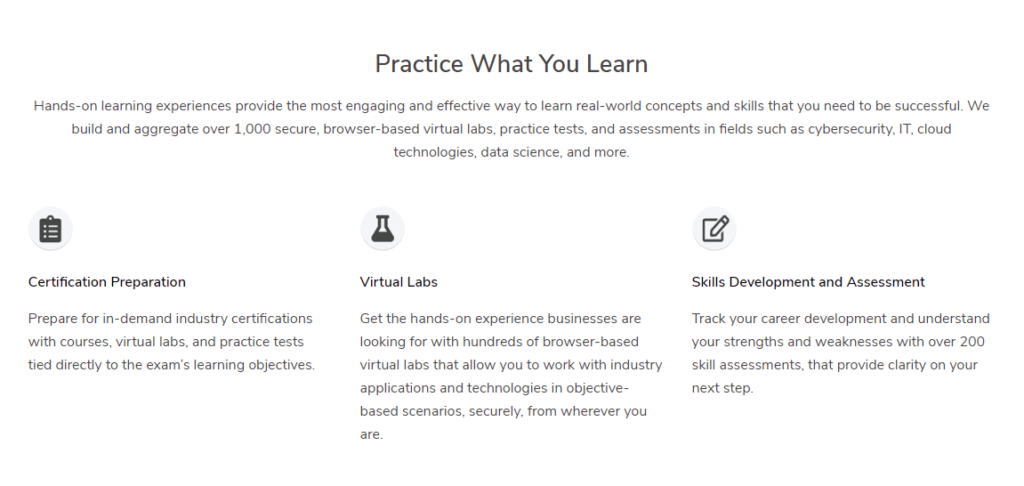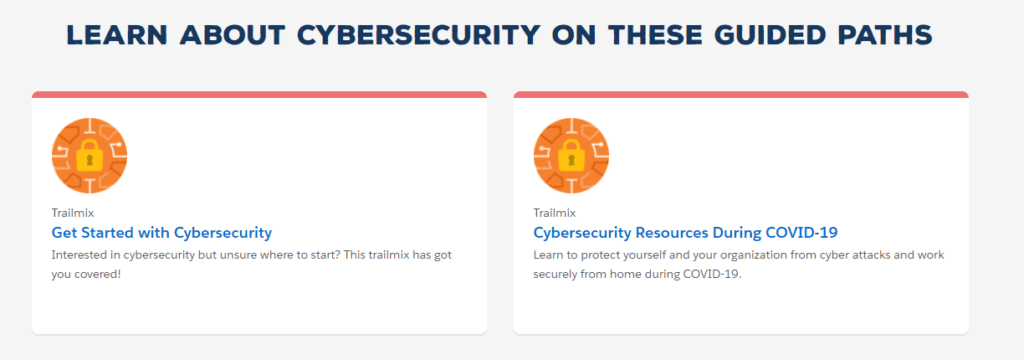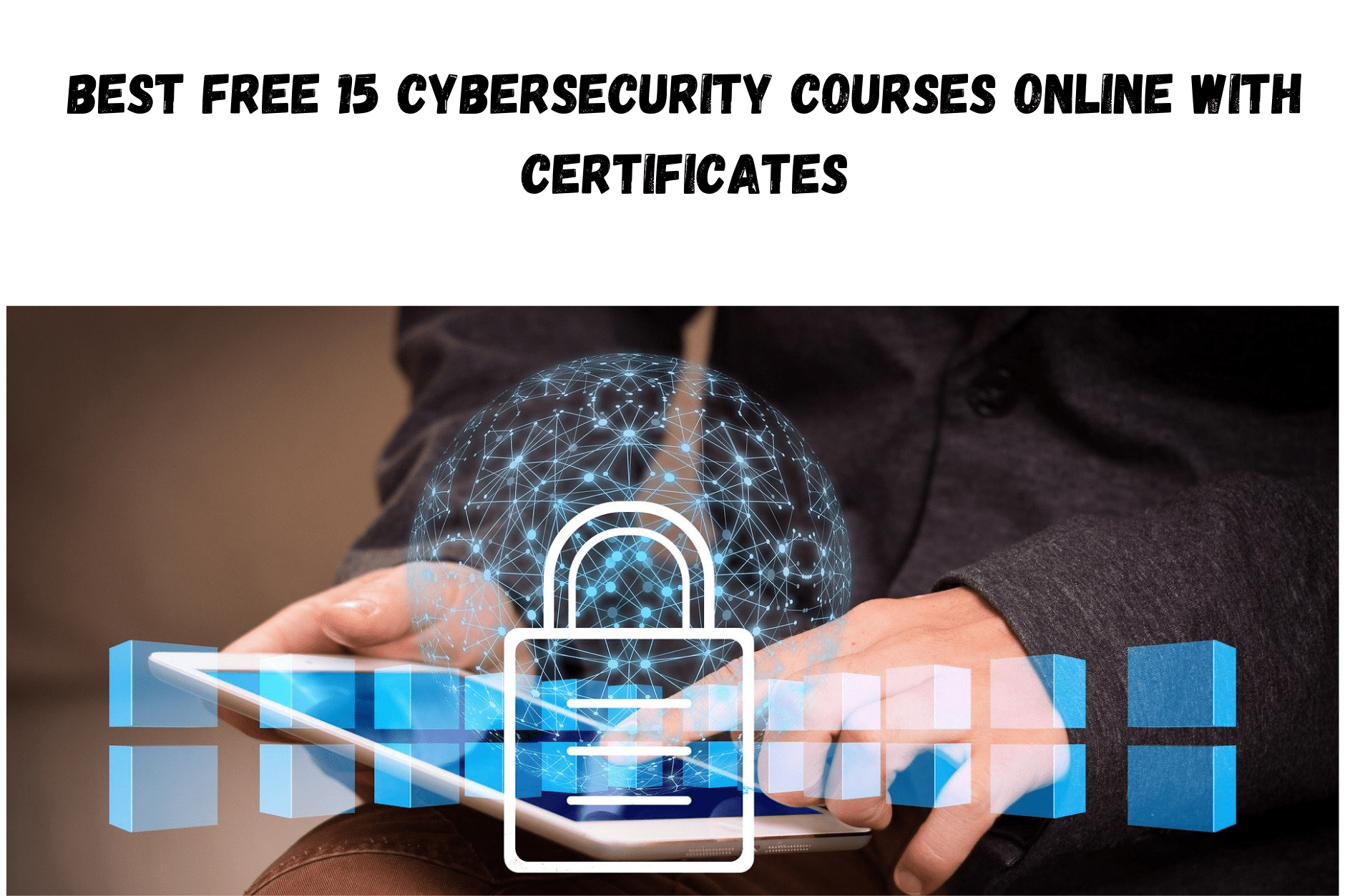Here is the list of Best Free 15 Cybersecurity courses online with certificates
1) Sans Cyber Aces
Table of Contents
SANS Cyber Aces Online is an online course that teaches the core concepts needed to assess, and protect information security systems.
The course was developed by SANS, the most trusted and the largest source for information security training and security certification in the world.
The course is an engaging, self-paced, easy to use combination of tutorial and videos.
It’s available as open courseware so you can take it anytime.
SANS is donating the course from their library of professional development curriculum.
Do I have to register?
No. SANS Cyber Aces Online is available as open courseware, so registration is not required to access the course content.
Is there a fee?
No. SANS Cyber Aces Online is free for all participants.
Course : Learn the fundamentals of cybersecurity.
The course covers the three foundation areas of information security.
- Operating Systems
- Networking
- Systems Administration
You Might like : Paloalto Ignite’20 Free cybersecurity vouchers and training
1. Introduction to Operating Systems
- Linux
- Windows
2. Networking
- Introduction and Layer 1
- Layer 2 – Data Link
- Layer 3 – Network, Part 1: Addressing & Masking
- Layer 3 – Network, Part 2: Routing
- Layer 3 – Network, Part 3: Communication
- Layer 4 – Transport
- Layers 5 & 6 – Session and Presentation
- Layer 7 – Application
- Inter-Layer Communication & Conclusions
3. System Administration
- Bash Scripting
- PowerShell
- Python
2) Open Security
Current stats:
- 63 days of open source class materials
- 29 classes (13 with videos)
- 24 instructors
Classes are divided into beginner, Intermediate and Advanced levels
3) Future Learn – Intro Cybersec

- Duration:8 weeks
- Weekly study : 3 hours
- Cost : Free
You’ll learn how to recognise online security threats that could harm you and explore the steps you can take to minimise your risk.
The course will improve your online safety in the context of the wider world, introducing concepts like malware, trojan virus, network security, cryptography, identity theft, and risk management.
The course is supported by the UK Government’s National Cyber Security Programme, is GCHQ Certified Training and IISP accredited.
What topics will you cover?
- Threat landscape: terminology, cyber security threats, keeping up to date
- Authentication: access control, passwords, two-factor authentication
- Malware: types of malware, attack vectors, preventing infection
- Networking and communications: fundamentals, security challenges, standards
- Cryptography: symmetric and asymmetric cryptography, applications
- Network security: firewalls, virtual private networks, intrusion detection / prevention
- When your defences fail: cyber security laws, recovering from attacks
- Managing security risks: risk analysis and management
4) Charles Sturt : Cybersecurity Management
Free Short Course: Cybersecurity Management
| Difficulty | ■■■■ IntermediateMore Info |
| Duration | 5 Weeks |
| Enrolled | 12,948 students |
| Cost | Free! |
Course Schedule
| Module 1: | Effective and efficient cyber security |
| Cyber security fundamentalsWhy do we need cyber securityThe threat landscapeCommunicationPolicies and standards | |
| Module 2: | The Cyber security practice – warriors and critics |
| Scanning and testingCode reviewLog monitoringIncident response and investigationReview and compliance | |
| Module 3: | The cyber security practice – visionaries and leaders |
| Cyber security strategyEnterprise cyber security architectureProtective controlsDetective controlsThe cyber security program | |
| Module 4: | Putting it all together |
| Cyber security governance and managementObtaining and keeping the right staffManaging the cyber security practiceThe cyber security maturity modelManaging the senior leadership team | |
| Assessment: | Exam week |
| A free open-book online test:40 multiple choice questions (pass mark 50%)Duration: 1 hour |
Course Information Q&A
What is the aim of this short course?
The aim of the short course is to give you a ‘taster’ of what it is like to undertake postgraduate study via online learning with Charles Sturt University.
Who presents the webinars?
This short course was developed by Jeremy Koster. Jeremy has 19 years of experience in IT with over 11 years specialising in information security within large enterprises. Jeremy has a range of security qualifications such as CISM, CISSP, PCIP, GCIH, GPEN, CEH and CHFI. He completed his Masters of Information System Security with Charles Sturt University through the IT Masters program in 2006. He is a CompTIA Certified Technical Trainer and has been lecturing for CSU since 2011.
Is there a final exam?
Yes — the short course exam will be a timed, open book exam that you will sit at your computer.
Do I get a completion certificate if I complete the course?
Yes — provided you receive a pass mark (50% or over) for course assessment, which comprises the exam and any available participation marks.
5) Cybrary

The Leading Cybersecurity Professional Development Platform
- Hands-on experiences to gain real-world skills
- Guided career paths and role-based learning
- Industry certification courses with practice tests
- Dedicated mentors and professional networking

Get started in the IT industry for free!
- Introduction to IT & Cybersecurity (FREE!)
- CompTIA A+ (First Activity FREE)
- Cisco CCNA (First Activity FREE)
- CompTIA Linux+ (First Activity FREE)
- CISA (First Activity FREE)
- Computer Hacking & Forensics (First Activity FREE)
- Penetration Testing and Ethical Hacking (First Activity FREE)
- CISSP (First Activity FREE)
- CompTIA Security+ (First Activity FREE)
In addition to these Cybrary offers free monthly premium courses with Labs
6) University of Helsinki’s : Cyber Security Base 2020
The courses are offered by University of Helsinki’s Department of Computer Science.

About the Course Series
Cyber Security Base is a free course series by University of Helsinki and MOOC.fi in collaboration with F-Secure that focuses on building core knowledge and abilities related to the work of a cyber security professional.
Learn about tools used to analyse flaws in software systems, necessary knowledge to build secure software systems (esp. within Web), the skills needed to perform risk and threat analysis on existing systems and the relevant legislation within EU.
The course series consists of 6 smaller courses, each with a specific theme.
Themes include
- a brief introduction to cyber security,
- operational security,
- web software development,
- types of vulnerabilities
- typical of web software,
- discovery and mitigation of such vulnerabilities,
- and advanced topics such as secure software architectures and cryptography.
There will be several case studies as well as projects for participants.
At the end of the course series, a friendly capture-the-flag competition where participants will try to solve some security puzzles.
Each course is open for a certain period of time, and must be completed during that window.
Course descriptions and timetable
The course consists of 6 smaller courses that can and must be completed during a certain period of time. All course material is available on this web page when the course starts; however the material for the courses that have not yet started is not shown.
All course material is in English.
For students at University of Helsinki: the first 3 courses form a bachelor-level course Introduction to Cyber Security (TKT20009), while the last 3 courses form a master-level course Cyber Security II (CSM13204).
Introduction to Cyber Security 1 CR (ECTS)
Schedule: 31.08.2020-31.12.2020
This part of the course series will introduce the participant to the relevant issues in cyber security. These issues include the stakeholders’ and users’ ability to disrupt the functionality of a system; corporate responsibilities and liabilities; and the never-ending software crisis that is related to the increasing amount of software and maintenance.
Securing Software 3 CR (ECTS)
Schedule: Sep., 2020 – 31.12.2020
This part focuses on security issues related to interconnected software. The participant will learn the principles of developing web applications, typical security issues that are related to such applications, and how such issues are discovered and mitigated.
Course Project I 1 CR (ECTS)
Schedule: Sep., 2020 – 31.12.2020
In the first project, the participants will construct software with security flaws, point out the flaws in the project, and provide the steps to fix them.
Advanced Topics 3 CR (ECTS)
Schedule: Feb., 2021 – 31.12.2021
This part focuses on security in networks, including internet security issues, issues in 4G networks as well as the issues and remedies planned for the upcoming 5G network. This includes also relevant cryptography topics. Architectural analysis of existing (software) systems will be also visited, and selected methods for log mining for the purposes of identifying and tackling attacks will be studied.
Course Project II 1 CR (ECTS)
Schedule: Feb., 2021 – 31.12.2021
In the second project, the participants will install an operating system with a variety of vulnerabilities and then install a network intrusion prevention system into it. Subsequently, the participants will familiarize themselves with penetration testing software, and attack the system they installed.
Capture The Flag 1 CR (ECTS)
Schedule: will be announced later
A Capture the Flag (CTF) competition will be organized at the end of the course series. In the competition, participants will be given a variety of tasks that are related to the topics of the course series. Participants will gain points for every solved task. The amount of points depends on the complexity of the task as well as the amount of time that the spent on the task.
7) WebSecurity Academy
Free online web security training from the creators of Burp Suite
- Learn about security vulnerabilities
- Practice hacking like a professional
- Test yourself in our interactive labs
- Track your progress


The Web Security Academy is a free online training center for web application security.
It includes content from PortSwigger’s in-house research team, experienced academics, and our founder Dafydd Stuttard – author of The Web Application Hacker’s Handbook.
Unlike a textbook, the Academy is constantly updated. It also includes interactive labs where you can put what you learn to the test.
If you want to improve your knowledge of hacking, or you’d like to become a bug bounty hunter or pentester, you’re in the right place.
8) Using MITRE ATT&CK for Cyber Threat Intelligence Training
This training by Katie Nickels and Adam Pennington of the ATT&CK team will help you learn how to apply ATT&CK and improve your threat intelligence practices.
Using ATT&CK for Cyber Threat Intelligence Training

The goal of this training is for students to understand the following:
- What ATT&CK is and why it’s useful for cyber threat intelligence (CTI)
- How to map to ATT&CK from both finished reporting and raw data
- Why it’s challenging to store ATT&CK-mapped data and what you should consider when doing that
- How to perform CTI analysis using ATT&CK-mapped data
- How to make defensive recommendations based on CTI analysis
The training contains five modules that consist of videos and exercises that are linked below.
This training was designed to be completed in approximately 4 hours, and may be completed solo or as a team.
A copy of all slides from the training are here.
The exercises in this training are based on a previous version of ATT&CK. We recommend using ATT&CK v6 and ATT&CK Navigator v2 if you want to match the training.
Training Modules
Module 1: Introducing training and understanding ATT&CK
Module 2 with Exercise 2: Mapping to ATT&CK from finished reporting
Module 3 with Exercise 3: Mapping to ATT&CK from raw data
Module 4 with Exercise 4: Storing and analyzing ATT&CK-mapped intel
Module 5 with Exercise 5: Making ATT&CK-mapped data actionable with defensive recommendations
9) Fortinet Free Cybersecurity Training
Free Technical Training for IT Professionals

In the no-cost FortiGate Essentials Training course, you will learn how to operate and administrate some fundamental FortiGate NGFW features.
By the end of the course, you will have a solid understanding of how to deploy and maintain a basic network security solution.
The course also covers how to enable users to remotely connect to your network in a secure way, enabling productive telework.
Using self-paced guided recordings, you will learn how to use firewall policies, user authentication, routing, and SSL VPN.
You will also learn how to protect your users by using web filtering and application control.
Start your training with FortiGate Essentials.

Free Cybersecurity Awareness Training for Teleworkers
Fortinet also has two no-cost non-technical courses targeted towards teleworkers and their families. We highly encourage people to take some time to educate themselves about proper security protocols to keep themselves and their organization’s networks safe.
Start your training with NSE 1 and NSE 2
10) Trailhead : Get Started with Cybersecurity
Free learning for individuals to develop their security knowledge and learn about careers in cybersecurity.
A collaboration between Fortinet, the World Economic Forum, Salesforce and the Global Cyber Alliance.


11) IBM OPEN TECH – Cybersecurity

Cybersecurity Fundamentals
Audience: Teachers
Cybersecurity professionals have a passion for securing systems and protecting data and have a keen interest in information technology.
Maybe you’re interested in a career in cybersecurity, or just want to learn more about this field? This channel is a great place to start.
12) IBM Security Learning Academy
Free Cybersecurity Training from IBM along with training on IBM security Products

13) Hacker101
Free, open-source video lessons on web security

Playlists
All Videos
- Introduction
- The Web In Depth
- XSS and Authorization
- SQL Injection and Friends
- Session Fixation
- Clickjacking
- File Inclusion Bugs
- File Upload Bugs
- Null Termination Bugs
- Unchecked Redirects
- Password Storage
- Crypto series
- Threat Modeling
- Writing Good Reports
- Burp Suite series
- Secure Architecture Review
- Server-Side Request Forgery
- Source Code Review
- XML External Entities
- Cookie Tampering Techniques
- Mobile App Hacking series
- Native Code Crash Course
- Pentest series
14) MIT OpenCourseWare

MIT provides a free online library of selected course materials used to teach MIT undergraduate and graduate courses. There are cybersecurity course materials available, but they are a number of years old.
- Advanced Topics in Cryptography
- Cryptography and Cryptoanalysis
- Distributed Computer Systems Engineering
- Network and Computer Security
- Selected Topics in Cryptography
15) Coursera – Massive Online Open Courses
Stanford University – Computer Security
In this class you will learn how to design secure systems and write secure code. You will learn how to find vulnerabilities in code and how to design software systems that limit the impact of security vulnerabilities. We will focus on principles for building secure systems and give many real world examples.
Stanford University – Cryptography I
This course explains the inner workings of cryptographic primitives and how to correctly use them. Students will learn how to reason about the security of cryptographic constructions and how to apply this knowledge to real-world applications. The course begins with a detailed discussion of how two parties who have a shared secret key can communicate securely when a powerful adversary eavesdrops and tampers with traffic. We will examine many deployed protocols and analyze mistakes in existing systems. The second half of the course discusses public-key techniques that let two or more parties generate a shared secret key. We will cover the relevant number theory and discuss public-key encryption and basic key-exchange. Throughout the course students will be exposed to many exciting open problems in the field.
Stanford University – Cryptography II
This course is a continuation of Crypto I and explains the inner workings of public-key systems and cryptographic protocols. Students will learn how to reason about the security of cryptographic constructions and how to apply this knowledge to real-world applications. The course begins with constructions for digital signatures and their applications. We will then discuss protocols for user authentication and zero-knowledge protocols. Next we will turn to privacy applications of cryptography supporting anonymous credentials and private database lookup. We will conclude with more advanced topics including multi-party computation and elliptic curve cryptography.
University of Maryland – Usable Security
This course focuses on how to design and build secure systems with a human-centric focus. We will look at basic principles of human-computer interaction, and apply these insights to the design of secure systems with the goal of developing security measures that respect human performance and their goals within a system.
University of Maryland – Software Security
This course we will explore the foundations of software security. We will consider important software vulnerabilities and attacks that exploit them — such as buffer overflows, SQL injection, and session hijacking — and we will consider defenses that prevent or mitigate these attacks, including advanced testing and program analysis techniques. Importantly, we take a “build security in” mentality, considering techniques at each phase of the development cycle that can be used to strengthen the security of software systems.
University of Maryland – Cryptography
This course will introduce you to the foundations of modern cryptography, with an eye toward practical applications. We will learn the importance of carefully defining security; of relying on a set of well-studied “hardness assumptions” (e.g., the hardness of factoring large numbers); and of the possibility of proving security of complicated constructions based on low-level primitives. We will not only cover these ideas in theory, but will also explore their real-world impact. You will learn about cryptographic primitives in wide use today, and see how these can be combined to develop modern protocols for secure communication.
University of Maryland – Hardware Security
This course will introduce you to the foundations of modern cryptography, with an eye toward practical applications. We will learn the importance of carefully defining security; of relying on a set of well-studied “hardness assumptions” (e.g., the hardness of factoring large numbers); and of the possibility of proving security of complicated constructions based on low-level primitives. We will not only cover these ideas in theory, but will also explore their real-world impact. You will learn about cryptographic primitives in wide use today, and see how these can be combined to develop modern protocols for secure communication.
We hope this list helps you to find your best path to cybersecurity learning.
